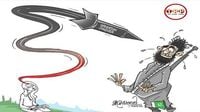Raipur: On the occasion of World Cartoonist Day, renowned cartoonist Sagar Kumar received special recognition from TRP. This honor was not merely an acknowledgment of his creative contributions but also a celebration of his relentless efforts to elevate Indian cartooning on the global stage.
Sagar Kumar has been active in the world of cartoons for nearly 29 years, and during this time, he has showcased Indian art and thought through his "cartoon wings" in countries like Japan, Brazil, South Africa, and America. His list of achievements is extensive. He was awarded the Fulbright Fellowship from the prestigious University of Pennsylvania for research on cartoons. Additionally, he represented India at the Microsoft Innovative Forum, where he ranked in the top 10 among participants from 178 countries, bringing pride to his nation.
For his contributions to journalism, Kumar has been honored twice with the National Award by the President of India. Alongside his accolades in journalism, he has also developed cartooning as an impactful learning tool in education. His innovative approach has been presented at several prominent institutions, including IIT Patna, Birla Education Trust Pilani, NCERT, and various state governments in Uttar Pradesh, Assam, and Jammu & Kashmir.
In his workshops, cartooning is viewed not just as entertainment but as a robust medium for education, expression, and innovation. In a conversation with ETV Bharat, famous cartoonist Triambak Sharma discussed the evolving nature of cartoons in today's digital landscape. He noted how cartoons have transitioned from satirical pieces in newspapers to forms of entertainment on television channels, and now, increasingly, onto social media platforms.
Sharma reflected on the differences between cartoons from the past and those of today, stating, "In the earlier days, newspapers held significant importance, and the cartoons published therein reached audiences nationwide. However, with the rise of social media, the relevance of newspapers has diminished, affecting the prominence of cartoons as well." He emphasized that many now view cartooning as a "dying art," suggesting that cartoonists are struggling to find their place in the media landscape.
Despite the challenges, Sharma encouraged aspiring cartoonists to pursue their passion while keeping realistic expectations. He advised, "If you want to earn a living from cartooning, you need to have a passion for it. Otherwise, it might be wise to consider other career options while keeping cartooning as a hobby." He underscored the importance of education and suggested that students focus on their studies and careers first before diving into cartooning.
Sharma also discussed the historical significance of cartoons in politics, explaining how they used to highlight the shortcomings of governments and politicians. He lamented that the current societal climate has made people less tolerant of criticism, which has affected the impact of political cartoons. "People today have less patience for criticism, and this change in social dynamics has made it more challenging for cartoonists to convey their messages," he noted.
As the conversation shifted to the challenges faced by cartoonists today, Sharma acknowledged the rise of artificial intelligence (AI) in creative fields. He stated, "When computers first emerged, many predicted that they would replace jobs, but that hasn't happened. AI may assist in creating content, but it cannot replicate the unique thoughts and creativity that come from the human mind. Therefore, I don't see AI as a threat to our existence as cartoonists."
He also pointed out that AI has facilitated the distribution of cartoon content, allowing more people to create and share their work. "The difference between hand-drawn cartoons and those created by AI is significant; original creations will always hold a unique value that duplicates cannot replicate," he said.
Sharma expressed concern over the limited number of successful cartoonists emerging from Chhattisgarh, attributing it to the nature of the art form itself. He explained, "Cartooning has always been a niche field, and while many students graduate with degrees in cartooning, not all manage to create impactful work. Cartooning is not just a skill that can be taught; it requires a keen intellect and a unique perspective on the world, which comes from practice and experience."
Finally, he addressed the decline in comic reading among the younger generation, noting that animation has largely taken its place. "As people increasingly prefer visual content over reading, the demand for comics has diminished. However, readers and viewers have their preferences, and both forms of media can coexist," he added.
As a parting message for aspiring cartoonists, Sharma suggested exploring caricature art as an alternative path. He explained that caricature requires less intricate commentary and can be a viable way to earn a living while still engaging with the art of cartooning. "Those interested in cartooning should consider starting with caricatures before advancing to more complex cartooning techniques," he advised.
In summary, the world of cartooning is undergoing significant changes, influenced by technology and shifting societal attitudes. While challenges abound, the passion for this art form continues to inspire many, as evidenced by the recognition of artists like Sagar Kumar and the insights shared by Triambak Sharma.




